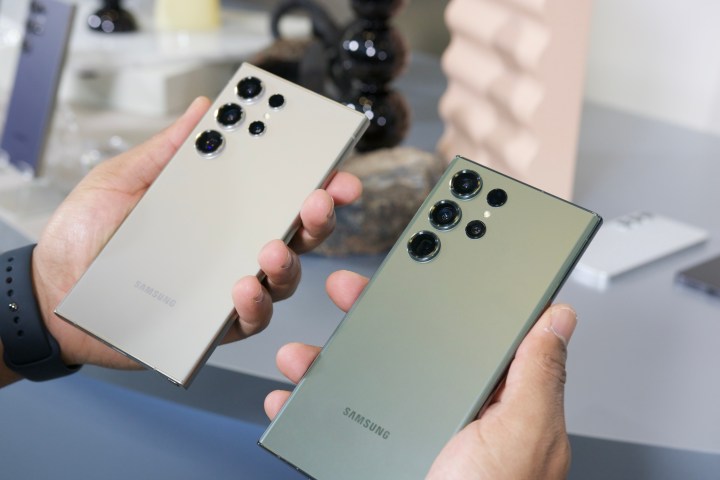
The premium Android space does not suffer from a lack of options. There are plenty of good flagships with excellent performance, bright and visually enticing screens, glamorous designs, and cameras that trick you into thinking they are as good as DSLRs. The Galaxy S series ticks most of those boxes, and the new Galaxy S24 Ultra doesn’t waver from the expectations set by its ancestors.
With AI being the keyphrase of the Samsung Unpacked event this year, the S24 Ultra is gaining significant improvements in ways we can interact with phones. In many ways, the Galaxy S24 Ultra will lead as one of the most compelling and feature-rich Android phones of 2024. But is it enough to tempt owners of the Galaxy S23 Ultra to upgrade?
If you are curious about the improvements the Galaxy S24 Ultra brings over last year’s S23 Ultra, here’s everything you need to know.
Galaxy S24 Ultra vs. S23 Ultra: specs
| Samsung Galaxy S24 Ultra | Samsung Galaxy S23 Ultra | |
|---|---|---|
| Size | 162.5 × 79 × 8.6mm (6.40 x 3.11 x 0.34 inches) | 163.4 × 78.1 × 8.9mm (6.43 x 3.07 x 0.35 inches) |
| Weight | 233 grams (8.22 ounces) | 234 grams (8.25 ounces) |
| Screen |
|
|
| Operating system | One UI 6.1 based on Android 14 | Upgradable to One UI 6.1 based on Android 14 |
| RAM & Storage |
|
|
| Processor | Qualcomm Snapdragon 8 Gen 3 “For Galaxy” | Qualcomm Snapdragon 8 Gen 2 “For Galaxy” |
| Camera |
|
|
| Video |
|
|
| Connectivity |
|
|
| Ports | USB-C | USB-C |
| Water resistance | IP68 | IP68 |
| Battery & charging | 5,000mAh with 45W wired fast charging and 15W wireless charging | 5,000mAh with 45W wired fast charging and 15W wireless charging |
| Colors | Black, Gray, Violet, Yellow | Black, Green, Cream, Graphite, Sky Blue, Lime, Red |
| Price | Starting at $1,300 | Starting at $1,200 |
Galaxy S24 Ultra vs. S23 Ultra: design
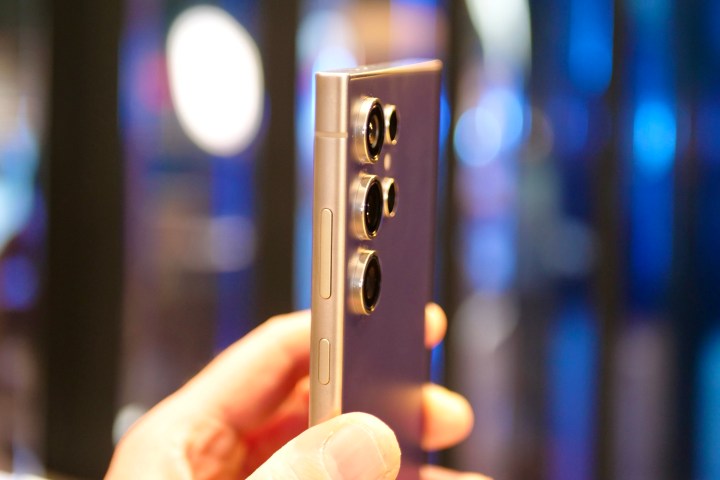
With each progressing year, Samsung has followed the same ideology as Apple, launching new flagships with minimal design changes. The Galaxy S23 Ultra received only minor changes over the S22 Ultra, which itself adopted the same design as the Galaxy Note 20 Ultra when Samsung decided to converge the two series.
Likewise, the new Galaxy S24 Ultra doesn’t differ much from the Galaxy S23 Ultra and bears only minimal changes in design. The most significant modification the Galaxy S24 Ultra undergoes is a new frame crafted with titanium instead of a hardened aluminum alloy previously. Once again, this decision appears to be inspired by Apple’s adaptation of titanium for the iPhone 15 Pro‘s chassis. While Samsung says the titanium will help the device’s longevity, there are no solid claims about measurable improvements. Visibly, the updated frame may appear more textured than the Galaxy S23 Ultra’s shiny frame with a chrome finish.
Another noticeable change over the Galaxy S23 Ultra is the Galaxy S24 Ultra’s new flat display. In reality, the display isn’t entirely flat, but the curvature of the edges has been reduced significantly, and the curved part of the screen now mostly overlaps the bezels along the screen. While people are irresolvably divided over the topic of curved screens, Samsung says the new display improves readability and productivity. For more durability, the Galaxy S24 Ultra is switching to the latest generation of Corning’s Gorilla Glass — i.e., Gorilla Glass Armor, with a claimed four times more resistance to scratches and the ability to cut reflection by up to 75%.
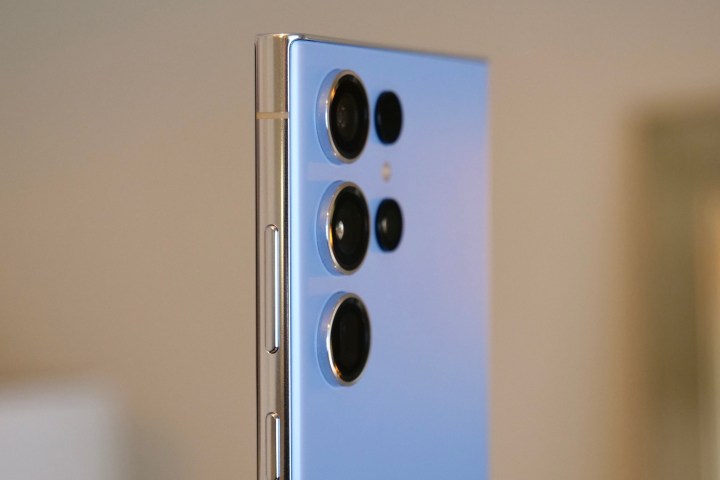
The switch from curved to flatter display edges does not impact the viewing area of the display (at least not noticeably enough). However, there are minor adjustments to the overall dimensions of the phone, which is now taller and slightly less broad than last year. The Galaxy S24 Ultra is also marginally thicker but weighs precisely the same as last year despite switching over to titanium, which is generally perceived to be lighter than aluminum.
Alongside the new frame, Samsung also brings newer colors, including yellow (another iPhone inspiration?), gray, and violet, to complement the already-existing black. There are also additional colors exclusive to Samsung’s website.
Besides the frame and the display, the Galaxy S24 Ultra’s design is pretty much the same as last year’s. The attributes carried over from the previous year include disjointed circular rings for different rear cameras and the laser autofocus module, a flattened frame to ease gripping, and the slot for the S Pen. While the placement of the buttons remains unchanged, Samsung now claims to use 10% recycled thermoplastics to make them. The cameras themselves have slightly changed, along with some other internal components that we discuss in the later sections.
Galaxy S24 Ultra vs. S23 Ultra: display
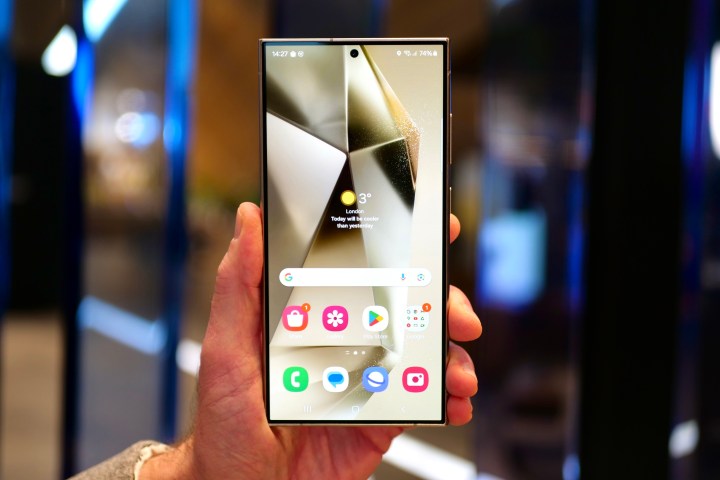
As mentioned previously, the Galaxy S24 Ultra sports a new display. Besides the physical changes to the panel, the Galaxy S24 Ultra’s display is much brighter and now boasts a peak brightness of 2,600 nits (a unit of intensity of light) as compared to the Galaxy S23 Ultra’s 1,750 nits of peak brightness. It is worth highlighting that “peak brightness” only represents the highest brightness of individually lighting pixels, primarily while viewing HDR content.
Meanwhile, other values — such as typical brightness and High Brightness Mode (HBM) — represent the maximum brightness of the panel as a whole; the latter indicates brightness triggered manually or under strong ambient lighting, such as under the sun. Samsung does not reveal the brightness values in other modes, but we should learn more in this respect over the coming days as we review the Galaxy S24 Ultra and compare it further with its predecessor.
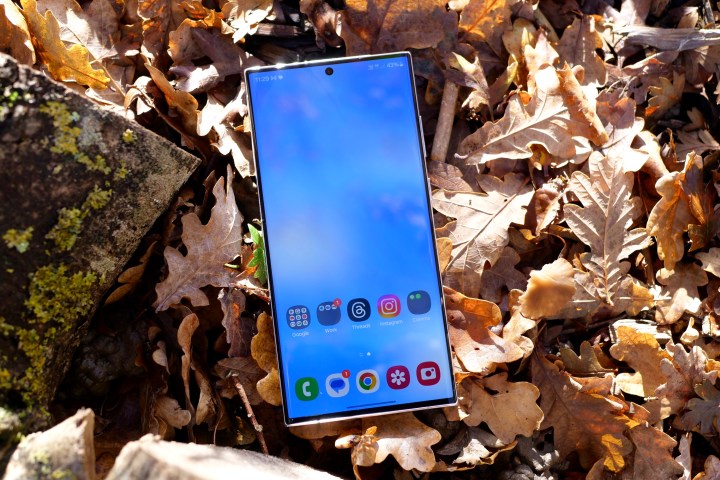
Besides the brightness and the design, there isn’t much to distinguish it from the previous year’s model. That’s simply because you don’t need to fix something that’s not broken. Samsung has been a pioneer in displays; it has a long legacy of providing displays for other phones, including the iPhone and OnePlus flagships, and its prowess shows here as well.
“Dynamic AMOLED 2X” is the formal marketing jargon to describe the LTPO display, which supports a variable refresh rate ranging between 1 and 120Hz, syncing to the frame rate of the contents of the display to avoid tearing or glitches.
The display once again sports a Quad HD+ resolution and supports 100% of the colors in the DCI-P3 gamut. Like previous generations, the Galaxy S24 Ultra supports HDR10+ codec but lacks Dolby Vision support. Given the brighter panel, our concerns about the last generation’s inability to compete with cheaper screens that support Dolby Vision might be alleviated to some extent.
Galaxy S24 Ultra vs. S23 Ultra: performance
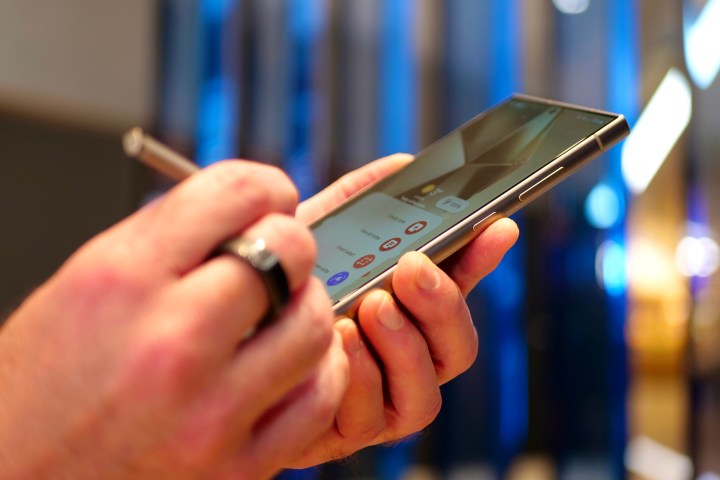
Perhaps the most significant change that the Galaxy S24 Ultra gets over the S23 Ultra is the hardware that powers it. The Galaxy S24Ultra is driven by a Qualcomm Snapdragon 8 Gen 3 chipset, launched in October 2023, making it the earliest phone with this chip to launch globally.
Qualcomm largely altered the orientation of CPU cores on the Snapdragon 8 Gen 3, prioritizing performance and resulting in a claimed 30% performance boost over the Snapdragon 8 Gen 2. Qualcomm also claims a 25% improvement in graphics performance, which should predominantly translate to a better gaming experience. In addition, Samsung is partnering with a few game studios to help make ray tracing more mainstream in Android games. The initial list of game titles with ray tracing support includes Diablo Immortal, Racing Master, Arena Breakout, and Night Crows.
The Galaxy S24 Ultra also has specific enhancements for better performance, including a 90% larger vapor cooling chamber than the S23 Ultra, allowing for better heat dissipation during performance-intensive tasks. In addition, 12GB RAM now comes as standard on all storage variants from 256GB to 1TB.

Besides more computing power, the Snapdragon 8 Gen 3 brings an astounding 98% boost in neural processing. Artificial intelligence tasks can now run on the device without relying on cloud-based data centers — at least, that’s the hypothesis Qualcomm shows. With generative AI and large language models such as ChatGPT and Google’s Bard becoming last year’s most sought-after tech products, Samsung is jumping on the bandwagon and introducing generative AI features on the Galaxy S24 series. Here are the AI features that the Galaxy S24 series offers:
- Live Translate allows real-time translation during calls with live transcription. Samsung claims that all the processing happens on the phone and no third-party services are required. However, you will be required to use the Samsung Dialer instead of the Google Phone app.
- Chat Assist will aid in generating text for third-party messaging apps such as WhatsApp or Google Messages, changing the tone to suit the conversation, and offering real-time translation of text messages. To use this service, you will need to use the Samsung Keyboard as your default keyboard app.
- Note Assist in the Samsung Notes app will use AI to summarize notes and make meaningful conclusions.
- Transcript Assist will automatically transcribe voice notes or recordings.
- Circle to Search will enable users to simply circle anything on the screen and specifically search that bit on Google instead of the entire screen’s contents.
- Android Auto will be able to summarize incoming messages and notifications while you are driving, but this feature will be available with an update in the future.
These AI features on the Galaxy S24 rely on Google’s Gemini Nano machine learning model, which suggests we might get to see them on other Android devices as well. On that note, Samsung has confirmed that these AI features are coming to the Galaxy S23 Ultra at a later date.
Apart from these, there are some applications of AI for the camera or editing images that we discuss in the camera section below. Pre-launch rumors also hinted at other applications, including an on-device chatbot with ChatGPT-like capabilities, AI-generated wallpapers, and weather-based lock screen animations, but Samsung has not yet mentioned these features. Given the chipset’s capabilities, these are feasible, and we hope Samsung will include them.
Galaxy S24 Ultra vs. S23 Ultra: battery and charging
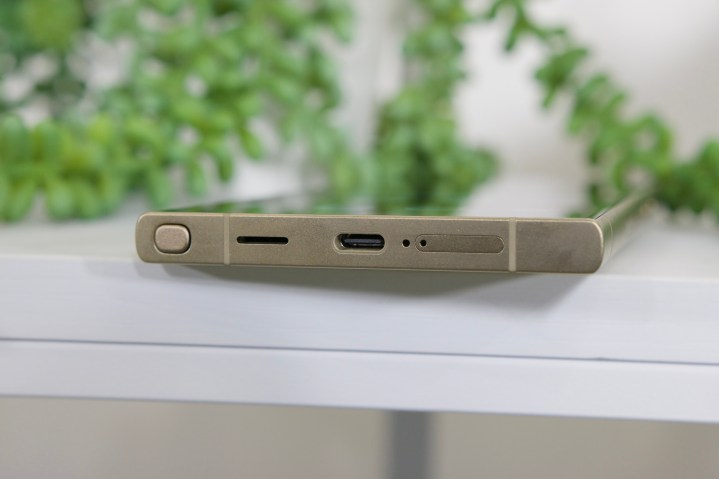
The Galaxy S24 Ultra continues to feature a 5,000mAh battery — the same as the S23 Ultra. If you are conscious about the environment, it might please you to know that 50% of the cobalt that Samsung is using for the Galaxy S24 Ultra’s battery is recycled. Besides the claimed environmental impact of this change, there might not be real-life improvements to the phone’s battery life.
In terms of charging, the Galaxy S24 Ultra still supports speeds up to 45 watts over a wired connection. Simultaneously, you can use a Samsung-branded or certified wireless charger to charge the phone at 15W or any other Qi-certified accessories at 5W. Besides these means to input charge, the Galaxy S24 Ultra also supports charging accessories such as Galaxy Buds or Galaxy Watch through reverse power sharing, which is capped at 3W.
Samsung does not say if the updated internals — or any AI algorithms — improve the Galaxy S24 Ultra’s battery life. But we shall also assess their impact over the coming days.
Galaxy S24 Ultra vs. S23 Ultra: cameras
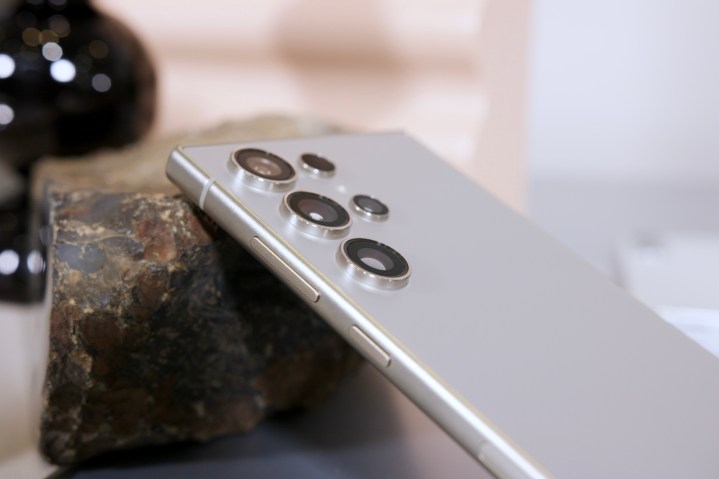
The Samsung Galaxy S23 Ultra was unquestionably one of last year’s best camera phones. This year, the Galaxy S24 Ultra appears prepared to take that title, all thanks to an improved 200MP sensor compared to the previous year.
Although the specifics are not immediately apparent from Samsung’s keynote, Samsung says the new sensor is 60% bigger than the Galaxy S23 Ultra’s ISOCELL HP2. This should allow for significantly more light, especially in dim scenarios, and allow for better night-time photography. Samsung further claims to have improved the optical image stabilization (OIS) on the Galaxy S24 Ultra, reducing jitters and lags due to shakes or movement.
Another significant change to the camera system is a new 5x periscopic telephoto sensor. On paper, it feels like a downgrade from the 10x periscope available on the Galaxy S23 Ultra, but Samsung is heavily relying on AI to enhance the quality of zoomed images and allow a seamless transition from 2x to 10x. Instead of zooming into the image, the Galaxy S24 Ultra crops a section of the image it actually takes, giving image quality that resembles optical zoom. The periscope can shoot at up to 100x zoom, and Samsung says these images will be “crystal clear” — presumably with the use of generative AI to reconstruct blurry parts as it already does with moon shots.
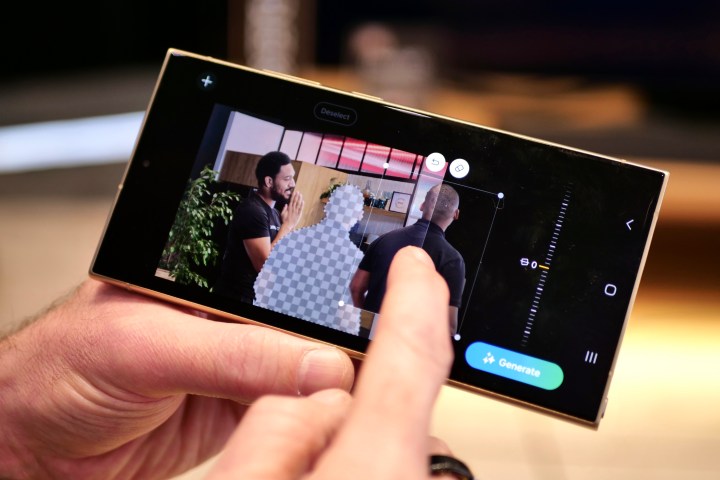
The other two sensors — the 12MP ultrawide and the 10MP telephoto with 3x zoom — remain unchanged. However, Samsung heavily relies on the Snapdragon 8 Gen 3’s AI capabilities to improve the camera’s performance.
The Galaxy S24 series leverages the Snapdragon 8 Gen 3’s on-device AI processing abilities to enhance images while they are being captured under the ambit of “ProVisual Engine.” The AI features come in handy in various ways, from sharpening images to reducing shutter lag. The AI will further help improve images by suggesting edits and allowing folks to create or replace parts of the photos with “Generative Edit,” similar to the Google Pixel 8 series.
Samsung’s cameras are often blamed for capturing photos with too much HDR, especially in low light. In response, it has now introduced Super HDR, allowing you to preview shots with HDR in the viewfinder as they would come out after processing. This might allow you to turn off HDR if it’s too aggressive. Samsung also mentions third-party apps such as Instagram will now be able to capture images or record videos with HDR. However, unlike the Pixel 8, the HDR metadata will not be recorded along with the photo, meaning they will not appear different on screens with and without HDR support.
Since most of these camera improvements are tied to better hardware — whether on the sensor or the chip level, we may not see them trickle down to older phones, especially the Galaxy S23 Ultra.
Galaxy S24 Ultra vs. S23 Ultra: software and updates
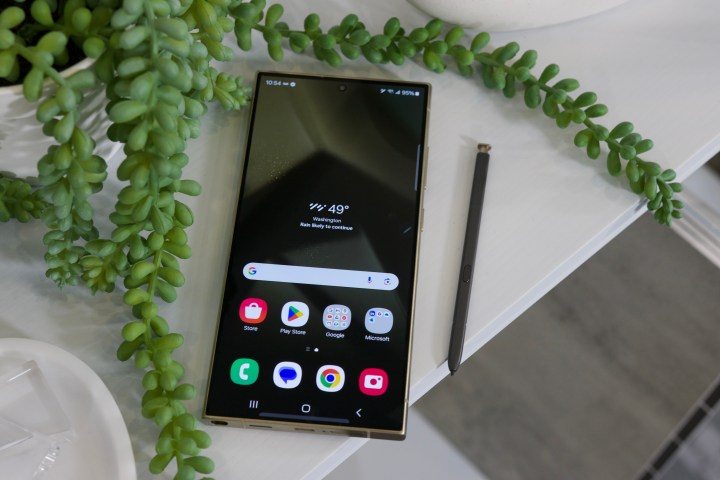
Samsung has already started rolling out its latest One UI 6 update based on Android 14 with significant design changes to a host of Galaxy S and A series devices. It is one of the most prominent visual updates to Samsung’s custom Android interface, bringing refinements to the quick settings panel, better wallpaper-based theming, a new font, and more.
The One UI 6 update has already been rolled out to the Galaxy S23 series, including the Ultra. So, there’s no reason for the Galaxy S24 Ultra to run an older version of the software. In fact, Samsung will offer additional features as part of the updated One UI 6.1, running out-of-the-box on the Galaxy S24 Ultra and other S24 devices.
Most of the features should eventually also be available on older devices such as the Galaxy S23 series. Samsung does not mention any customization features similar to the Pixel 8’s AI-generated wallpapers, but we might see them coming when the feature becomes more mainstream in the Android ecosystem.
With Google announcing seven years of firmware updates to the Pixel 8 series, Samsung is making similar claims and promising seven years of Android version and security updates to the Galaxy S24 series. This is one aspect that Galaxy S24 Ultra will outlast the S23 Ultra by several more years, despite being just one generation apart. This is because the Galaxy S23 Ultra will receive only three more Android version updates following Android 14.
Galaxy S24 Ultra vs. S23 Ultra: price and availability
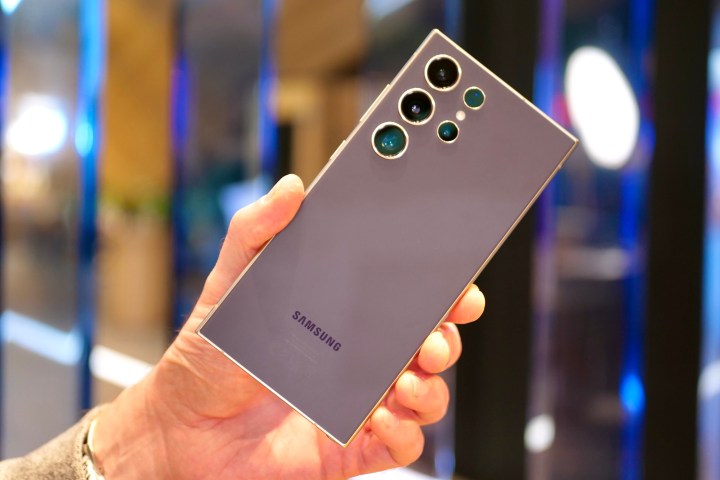
The Galaxy S24 Ultra will be sold in the U.S. for a starting price of $1,300, marking a $100 bump over the S23 Ultra’s initial pricing. It will be available starting January 31, 2024, with preorders starting January 17. If you preorder the Galaxy S24 Ultra by January 30, you can avail of a free storage upgrade and get the 512GB variant for the price of 256GB (or 1TB for the price of 512GB). You will receive an additional $100 in Samsung credits, which can be used to purchase something else on the brand’s website.
The Galaxy S23 Ultra is available for a starting price of $1,200, but you can find more attractive deals on third-party sellers such as
and
. Following the preordering period, we might witness price drops for the Galaxy S23 Ultra.
Galaxy S24 Ultra vs. S23 Ultra: verdict
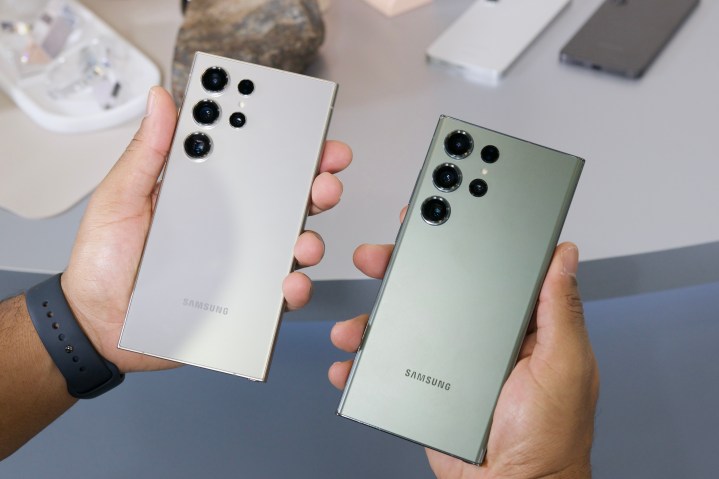
The Samsung Galaxy S24 Ultra is a clear upgrade over the S23 Ultra, with better performance, an improved display, and superior cameras. But what makes the choice for the Galaxy S24 Ultra a no-brainer over the S23 Ultra is the prolonged software support that Samsung offers on the former. With seven years of Android generation and security updates, the Galaxy S24 Ultra will receive active software support until Android 21, even though the hardware, especially the chipset, may not survive the brunt of generational improvements.
The only aspect where the Galaxy S23 Ultra still makes more sense than the Galaxy S24 Ultra is if Samsung manages to bring the price down significantly and make it a better value for money — or you get a lucrative deal from the small seller you befriended principally for that reason. Otherwise, you will be losing out on instant access to the new AI features and the promise of better usage in years to come.
However, if you already own a Galaxy S23 Ultra, you almost certainly don’t need to upgrade to the S24 Ultra. The S24 Ultra is technically better, sure, but the S23 Ultra is still a fantastic Android phone — and it’ll be getting most (if not all) of the Galaxy AI features that the S24 Ultra has.
Editors’ Recommendations










